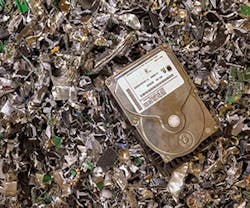E-Cycling Refresher
Do you have a stack of old computers and fax machines collecting dust in a dark corner of your facility?
Given how quickly technology becomes obsolete, electronics are one of the fastest growing sources of landfill waste. The EPA estimates that 2.37 million tons of computers, phones, printers, and televisions were discarded in 2009, yet only 25% were recycled.
Don’t let these bulky devices wind up in your dumpster. You can easily improve your diversion rates by dedicating a separate waste stream to electronics.
An Electrifying Problem
End-of-life electronics contain a number of heavy metals, such as mercury, lead, arsenic, and cadmium. Because these elements don’t biodegrade, they can leach into the ecosystem. Their presence can contaminate water and soil, as well as compromise plant and animal life.
They also pose a risk to human health, explains the e-Steward Initiative, a non-profit dedicated to electronics disposal. If improperly handled, these toxic materials can cause cancer, reproductive disorders, endocrine disruption, and other health problems.
Open-air burning and acid baths are commonly used to recover precious metals from electronics, notes the EPA, but they also expose workers to harmful substances.
And if e-waste is exported to other countries (an unregulated practice), it may not fall under regulations that ensure safe reclamation and disposal policies.
Before You Get Started
As you begin to collect devices, research if any restrictions apply to your region. There are currently 25 states with electronics recycling laws, notes the National Center for Electronics Recycling.
Many require manufacturers to provide recycling programs or ban certain electronics from going into the trash. Your local municipality or county landfill may also offer rebates or reduced fees for e-cycling.
Join forces with your IT department to facilitate the transfer of outdated equipment. A loading dock or maintenance shed is suitable for a cardboard baler or pop can bin, but electronics should be stored in a more secure area. The collection site needs to be free of moisture or temperature fluctuations to protect equipment integrity.
Data security also needs to be taken into account, the EPA cautions. As many devices can be refurbished and subsequently sold, electronics should be wiped before disposal. There are also companies that will salvage valuable materials and then destroy remaining parts.
Find the Right Partner
A reputable recycler is crucial – you don’t want someone to collect your materials only to dump them improperly.
The EPA encourages customers to contract with a certified recycler. Accreditations are offered through the Responsible Recycling Practices (R2) or e-Stewards, though some states have their own certification program.
Companies must demonstrate that they are safely handling and recycling electronics. This is established through an audit process.
“These certification programs are based on strong environmental standards that maximize reuse and recycling, minimize exposure to human health or the environment, ensure safe management of materials by downstream handlers, and require destruction of all data on used electronics,” says the EPA.
You can also donate equipment as a community service. There are many charity organizations that will rejuvenate technology. Children, non-profits, low-income families, or communities in developing nations may have a home for your old devices.
If your computers are less than two years old and you donate them to a school, for example, you may be able to earn a tax deduction under the 21st Century Classrooms Act for Private Technology Investment.
